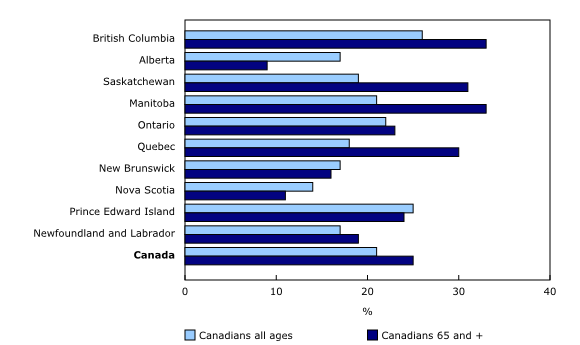Study: Inequities in pharmaceutical access and use
Released: 2022-11-02
In 2021, over one in every five (21%) adults in Canada reported not having any prescription insurance to cover medication costs. This lack of coverage sometimes meant delaying or skipping doses because of an inability to afford medication or paying higher out-of-pocket costs.
For example, non-adherence to prescription because of cost was reported by 17% of people without prescription insurance coverage, almost 2.5 times higher than those with coverage (7%). Also, those without insurance coverage who took or were prescribed medication ended up spending more out-of-pocket, with 27% spending $500 or more over the year preceding the survey compared with 16% with insurance coverage.
These findings are from a new study released today entitled Pharmaceutical access and use during the pandemic. The study offers insight into potential inequities in access to pharmaceuticals in Canada. This study uses data from the 2021 Survey on Access to Health Care and Pharmaceuticals During the Pandemic to examine pharmaceutical access and use across regions and sociodemographic groups.
A higher percentage of seniors, immigrants, and racialized persons report not having insurance to cover medication costs
Canada does not have universal coverage of prescription medication, and public drug plans offered by provinces can vary greatly in terms of eligibility, affordability, and drugs covered. As a result, the share of people reporting no prescription coverage varied considerably across the provinces in 2021, ranging from a high of 26% in British Columbia to a low of 14% in Nova Scotia.
Seniors (aged 65 years and over) were among the most likely to report not having prescription insurance to cover medication costs. In 2021, 25% of seniors reported not having prescription insurance coverage compared with 18% among adults aged 25 to 64 years. A higher percentage of seniors reported having no prescription coverage in British Columbia (33%) and Manitoba (33%), while a lower percentage of seniors reported this in Alberta (9%) and Nova Scotia (11%).
Immigrants and racialized persons were also more likely to report not having prescription insurance coverage. In 2021, 29% of immigrants reported not having prescription insurance to cover medication costs, compared with just over one-sixth (17%) of non-immigrants.
Racialized persons (29%) also had a higher percentage of reporting not having prescription insurance coverage compared with those who were non-racialized and non-Indigenous (17%). Among racialized persons, West Asians (41%), Chinese (33%), and Latin Americans (32%) were the most likely to report not having prescription medication coverage.
Employment characteristics likely contribute to differences in prescription insurance coverage by immigration status and racialized group, given that prescription insurance can also be offered by employers. For example, in 2021, the unemployment rate for immigrants was higher (8.4%) than for non-immigrants (7.0%). Immigrants also tend to have shorter-tenure jobs and work in lower-paying jobs compared with non-immigrants. Those occupying these types of jobs can be more susceptible to lay-offs and are also less likely to be offered insurance plans for prescription drugs.
Prescription medication use lower among people who did not have prescription insurance coverage
Almost two-thirds of adults who took or were prescribed medication reported spending less than $250 out-of-pocket in the 12 months preceding the survey. Moreover, nearly one in five (18%) reported spending $500 or more out-of-pocket for their prescription medication in the year preceding the survey. Spending this amount out-of-pocket was more common among those without insurance (27% compared with 16% of those with insurance).
Given the cost of taking prescription medication, not having prescription insurance may be an important barrier to accessing medication when needed. In fact, prescription medication use was lower among people who did not have prescription medication insurance to cover the cost of prescriptions compared with those who did have prescription medication insurance. Among people who reported having some level of prescription insurance coverage in 2021, 70% reported having taken or been prescribed medication in the 12 months preceding the survey, compared with 56% of those without prescription insurance coverage.
Note to readers
The Survey on Access to Health Care and Pharmaceuticals During the Pandemic was a voluntary survey conducted from March 8, 2021 to May 15, 2021 and collected information from over 25,000 respondents. The target population of the survey included persons 18 years of age or older living in the 10 provinces and excluded persons living on reserves and other Indigenous settlements in the provinces and the institutionalized population.
Definitions
Immigrants refer to persons who are, or who have ever been, landed immigrants or permanent residents. Such persons have been granted the right to live in Canada permanently by immigration authorities. Immigrants who have obtained Canadian citizenship by naturalization are included in this category. Non-immigrants refer to the Canadian-born.
Racialized persons refer to whether or not a person belongs to one of the 'visible minority' population groups defined by the Employment Equity Act. The Employment Equity Act defines 'visible minorities' as "persons, other than Aboriginal peoples, who are non-Caucasian in race or non-white in colour." The racialized population consists mainly of the following groups: South Asian, Chinese, Black, Filipino, Latin American, Arab, Southeast Asian, West Asian, Korean, and Japanese.
Products
The article entitled "Pharmaceutical access and use during the pandemic" is now available in Insights on Canadian Society (75-006-X).
The infographic "Pharmaceutical access and use" is now available in the series Statistics Canada - Infographics (11-627-M)
Contact information
For more information, or to enquire about the concepts, methods or data quality of this release, contact us (toll-free 1-800-263-1136; 514-283-8300; infostats@statcan.gc.ca) or Media Relations (statcan.mediahotline-ligneinfomedias.statcan@statcan.gc.ca).
- Date modified:

